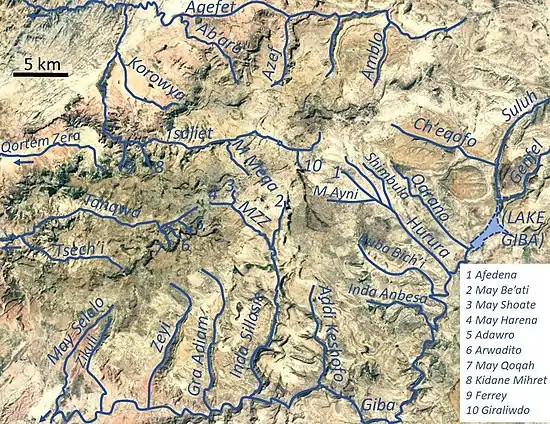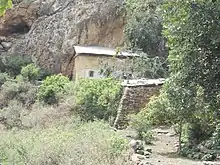Ab'aro
Ab’aro is a river of the Nile basin. Rising in the mountains of Dogu’a Tembien in northern Ethiopia, it flows northwestward to empty finally in Weri’i and Tekezé River.

| Ab'aro | |
|---|---|
 The Ab’aro cluse cuts across an outcrop of Adigrat Sandstone | |
 Ab’aro River in Dogu’a Tembien | |
| Location | |
| Country | Ethiopia |
| Region | Tigray Region |
| District (woreda) | Dogu’a Tembien |
| Physical characteristics | |
| Source | Ab’aro rock church |
| • location | Atsa in Haddinnet municipality |
| • elevation | 2,340 m (7,680 ft) |
| Mouth | Agefet River |
• location | NE of Addeha |
• coordinates | 13.7888°N 39.1414°E |
• elevation | 1,638 m (5,374 ft) |
| Length | 11.6 km (7.2 mi) |
| Width | |
| • average | 15 m (49 ft) |
| Basin features | |
| River system | Seasonal river |
| Landmarks | Ab’aro rock church, Kayeh Be'ati sandstone caves |
| Waterfalls | Rapids in Ab’aro cluse |
| Topography | Mountains, deep gorges and a sandy outwash plain |
Characteristics
Ab’aro is a confined ephemeral river in its upper part, whereas it widely meanders in the lower plains, with an average slope gradient of 60 metres per kilometre. Towards the footslope the river has cut a deep gorge (a cluse).[1]

Flash floods
Runoff mostly occurs in the form of high runoff discharge events that occur in a very short period (called flash floods). These are related to the steep topography, often little vegetation cover and intense convective rainfall. The peaks of such flash floods have often a 50 to 100 times larger discharge than the preceding baseflow.[1] In contrast to neighbouring rivers such as May Meqa, May Shoate or Giraliwdo, the magnitude of floods in Ab’aro has not been decreased due to interventions in the catchment. Physical conservation structures such as stone bunds[2][3] and check dams that intercept runoff[4][5] are absent. On the steep slopes, exclosures have not been established and there is no dense vegetation that could contribute to enhanced infiltration, less flooding or better baseflow.[6] As such, it is one of the few catchments that could stand model for conditions before major human interventions for conservation started in the Tigray region.
Lithology
From upstream to downstream, the following lithological units occur in the catchment. [7]

- Phonolite plugs
- Upper basalt
- Interbedded lacustrine deposits
- Lower basalt
- Amba Aradam Formation
- Antalo Limestone
- Quaternary freshwater tufa[8]
- Adigrat Sandstone
Logically, in the uppermost stretches of the river, only the pebbles and boulders of the upper lithological units will be present in the river bed, whereas more downstream one may find a more comprehensive mix of all lithologies crossed by the river.
Natural boundary
During its course, this river passes through two woredas and constitutes their border for 2 kilometres.[9] On the various parts:
- Dogu’a Tembien to the southeast
- Kola Tembien to the northwest
Transhumance towards Ab'aro
The valley bottoms in along middle Ab'aro have been identified as a transhumance destination zone. Transhumance takes place in the summer rainy season, when the lands near the villages are occupied by crops. Young shepherds will take the village cattle to the gorge and overnight in small caves. The gorges are particularly attractive as a transhumance destination zone, because there is water and good growth of semi-natural vegetation.[10]
Trekking along the river

A trekking routes winds across and along this river.[11] The tracks are not marked on the ground but can be followed using downloaded .GPX files.[12] Trek Gh2 roughly follows the river, partly occupying the track of an old road dating back to the time of the Italian occupation.[13] In the rainy season, flash floods may occur and it is advised not to follow the river bed.[14]
See also
References
- Amanuel Zenebe, and colleagues (2019). The Giba, Tanqwa and Tsaliet rivers in the headwaters of the Tekezze basin. In: Geo-trekking in Ethiopia's Tropical Mountains - The Dogu'a Tembien District. SpringerNature. doi:10.1007/978-3-030-04955-3_14. ISBN 978-3-030-04954-6.
- Nyssen, Jan; Poesen, Jean; Gebremichael, Desta; Vancampenhout, Karen; d'Aes, Margo; Yihdego, Gebremedhin; Govers, Gerard; Leirs, Herwig; Moeyersons, Jan; Naudts, Jozef; Haregeweyn, Nigussie; Haile, Mitiku; Deckers, Jozef (2007). "Interdisciplinary on-site evaluation of stone bunds to control soil erosion on cropland in Northern Ethiopia". Soil and Tillage Research. 94 (1): 151–163. doi:10.1016/j.still.2006.07.011. hdl:1854/LU-378900.
- Gebeyehu Taye and colleagues (2015). "Evolution of the effectiveness of stone bunds and trenches in reducing runoff and soil loss in the semi-arid Ethiopian highlands". Zeitschrift für Geomorphologie. 59 (4): 477–493. Bibcode:2015ZGm....59..477T. doi:10.1127/zfg/2015/0166.
- Nyssen, J.; Veyret-Picot, M.; Poesen, J.; Moeyersons, J.; Haile, Mitiku; Deckers, J.; Govers, G. (2004). "The effectiveness of loose rock check dams for gully control in Tigray, Northern Ethiopia". Soil Use and Management. 20: 55–64. doi:10.1111/j.1475-2743.2004.tb00337.x.
- Etefa Guyassa and colleagues (2017). "Effects of check dams on runoff characteristics along gully reaches, the case of Northern Ethiopia". Journal of Hydrology. 545 (1): 299–309. Bibcode:2017JHyd..545..299G. doi:10.1016/j.jhydrol.2016.12.019. hdl:1854/LU-8518957.
- Descheemaeker, K. and colleagues (2006). "Runoff on slopes with restoring vegetation: A case study from the Tigray highlands, Ethiopia". Journal of Hydrology. 331 (1–2): 219–241. doi:10.1016/j.still.2006.07.011. hdl:1854/LU-378900.
- Sembroni, A.; Molin, P.; Dramis, F. (2019). Regional geology of the Dogu'a Tembien massif. In: Geo-trekking in Ethiopia's Tropical Mountains — The Dogu'a Tembien District. SpringerNature. ISBN 978-3-030-04954-6.
- Moeyersons, J. and colleagues (2006). "Age and backfill/overfill stratigraphy of two tufa dams, Tigray Highlands, Ethiopia: Evidence for Late Pleistocene and Holocene wet conditions". Palaeogeography, Palaeoclimatology, Palaeoecology. 230 (1–2): 162–178. Bibcode:2006PPP...230..165M. doi:10.1016/j.palaeo.2005.07.013.
- Jacob, M. and colleagues (2019). Geo-trekking map of Dogu'a Tembien (1:50,000). In: Geo-trekking in Ethiopia's Tropical Mountains - The Dogu'a Tembien District. SpringerNature. ISBN 978-3-030-04954-6.
- Nyssen, Jan; Descheemaeker, Katrien; Zenebe, Amanuel; Poesen, Jean; Deckers, Jozef; Haile, Mitiku (2009). "Transhumance in the Tigray highlands (Ethiopia)". Mountain Research and Development. 29 (3): 255–264. doi:10.1659/mrd.00033.
- Description of trekking routes in Dogu'a Tembien. In: Geo-trekking in Ethiopia's Tropical Mountains - The Dogu'a Tembien District. GeoGuide. SpringerNature. 2019. doi:10.1007/978-3-030-04955-3. ISBN 978-3-030-04954-6. S2CID 199294303.
- "Public GPS Traces tagged with nyssen-jacob-frankl".
- Consociazione turistica Italiana. Guida dell'Africa orientale Italiana. Milano.
- Nyssen, Jan (2019). "Logistics for the Trekker in a Rural Mountain District of Northern Ethiopia". Geo-trekking in Ethiopia's Tropical Mountains. GeoGuide. Springer-Nature. pp. 537–556. doi:10.1007/978-3-030-04955-3_37. ISBN 978-3-030-04954-6.